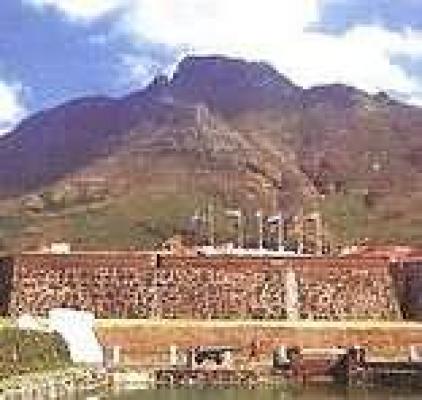The Castle of Good Hope is the oldest surviving building in South Africa.
Built between 1666 and 1679, this pentagonal fortification replaced a small clay and timber fort built by Commander Jan van Riebeeck in 1652 upon establishing a maritime replenishment station at the Cape of Good Hope (Cape Town) for the Dutch East India Company, better known as the VOC (Verenigde Oos-Indische Compagnie).
On 26 April 1679 the five bastions were named after the main titles of Willem, the Prince of Orange. The Western bastions was named Leerdam ; followed in clockwise order by Buuren, Catzenellenbogen, Nassau and Orange.
In 1936 the Castle was declared a National Monument. As a result of an extensive, ongoing restoration and conservation programme launched in the 1980's , the Castle of Good Hope remains the best preserved of its kind built by the VOC in regions where it had interests.
The Cape of Good Hope houses the regional headquarters of the South African Army in the Western Cape, the famous William Fehr Collection of historic artworks, the Castle Military Museum and ceremonial facilities for traditional Cape Regiments.
The main entrance to the Castle bears many reminders of the nearly one and a half centuries of VOC presence at the Cape.
This entrance is a unique example of 17th century Dutch classicism. The bell, cast in 1697 by Claude Fremy in Amsterdam, still hangs in the tower from its original wooden beams.
The Castle of Good Hope was built in accordance with 17th century European principles of fortification comprising strong bastions from which the outside walls could be protected by cross-fire.
During restoration of the inner courtyard, the foundations of the early 18th century bakery and pool were discovered. The building, currently known as Het Bakhuys ('t Bakhuijs), has been reconstructed on these foundations.
This museum depicts the military history of the Cape, the Castle and Cape Regiments.
This collection consists of artworks reflecting many aspects of cultural life at the Cape from the early VOC days until the end of the 19th century. Exhibitions of a contemporary nature are occasionally presented.
Sections of the moat, once a part of the Castle's system of defence, were rebuilt restorations.
Guided Tours are conducted from Monday to Saturday at 11h00, 12h00 and 14h00 (except on Sundays).
The Key Ceremony is performed Weekdays at 10h00 and 12h00, followed by the firing of the Signal Cannon.
Enquiries:
Tel: 021 787 1260
Entrance fees (subject to change):
Adults R28.00
Pensioners R15.00
Students R12.00
Children R12.00
Booked School Groups R5.00
Cape Town Accommodation options are numerous; with a large variety of different types spread throughout the Peninsula.
Cape Town offers a myriad of other Museums as well as other Things to Do and places to see, whatever your tastes, inclinations or budget.



